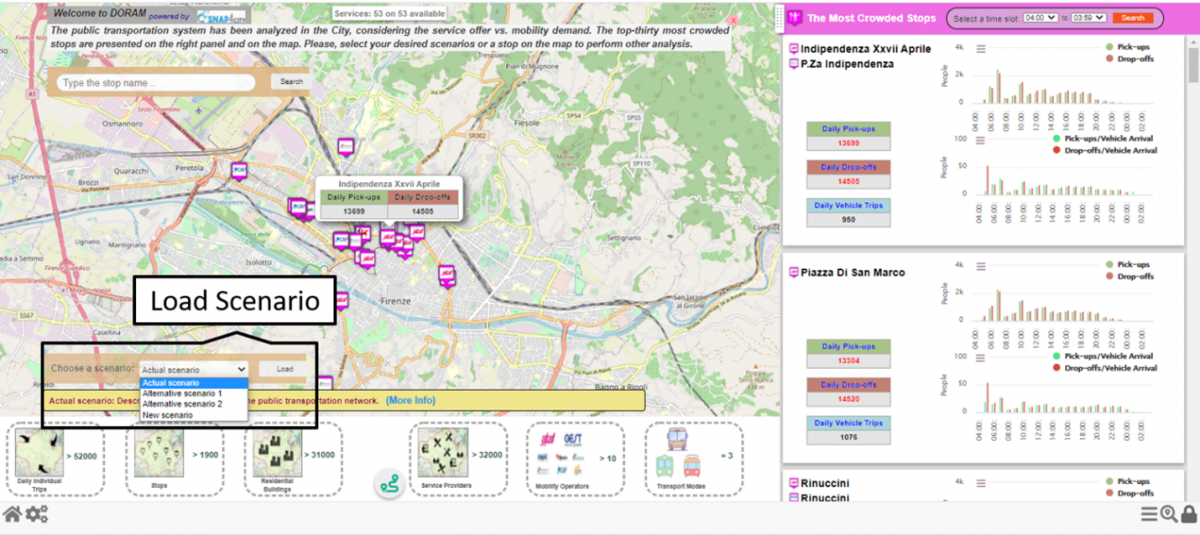Problem Statement and Motivation
In actual scenario, which describes the current status of the public transportation network and presented here, P.Za Indipendenza stop is the most crowded stop with more than pick-ups and drop-offs from to which is usually the peak hour in the morning in Florence. It indicates that a considerable amount of people daily waiting at P.Za Indipendenza stop during a typical working day, especially in time interval Such a situation could cause [1]:
- High passenger destiny at the stop
- negative impact on physical and psychological health (e.g., anxiety, stress)
- negative impact on personal safety and security
- etc.
- Increasing waiting time at the stop
- Decreasing operating speed
- Decreasing travel time reliability
The abovementioned issues could change the habitual traveling behavior of people because they find services offered by mobility operators impossible to use or at least unattractive, and as a result, give sufficient motivation to adopt different (e.g., private, shared) modes of transportation for traveling [2]. Such a situation would include several consequences (e.g., extra fuel consumption, noise, and air pollution, extensive land-use [3]). Therefore, it is essential to carefully address the cited issues to avoid the consequences by monitoring and balancing the number of waiting people at crowded stops.
Possible Solution
Considering a stop, a possible solution to mitigate the problem is Alternative Scenario 1 which includes the following steps (see Figure 1):
- Scenario Design
- a new stop, named new_P.Za Indipendenza, is added
- two lines, which are the most frequent lines among those that pass through P.Za Indipendenza stop are transferred to new_P.Za Indipendenza stop
in a way that, while not changing the service offer that is provided by the mobility operators, commuters are distributed to different stops. As a result, instead of making people to be picked-up or dropped-off at a stop, it is possible to ask some of them to choose the other added stop(s) for commuting.
- When Alternative Scenario 1 was designed, a tool, named Static GTFS Manager, used to configure the service offer in GTFS format
- The new service offer (in GTFS format), together with the mobility demand, added to the knowledgebase
- DORAM model is executed, considering Alternative Scenario 1
- The user can see the results in DORAM interface
For detail on how to create an alternative scenario, one could refer to here. Alternative Scenario 1 can be loaded in DORAM by selecting it from the respective drop-down menu (see Figure 2).

Figure 1. Alternative Scenario 1 overview

Figure 2. Loading Alternative Scenario 1
The following table shows a comparison between Actual Scenario and Alternative Scenario 1. As can be seen, considering P.Za Indipendenza, there are 16 passing lines and 41 passing trips in Alternative Scenario 1 while there are 18 passing lines and 63 passing trips in Actual Scenario. Also, there are and pick-ups and drop-offs at the stop in Actual Scenario while the same numbers respectively are .. and .. in Alternative Scenario 1. Therefore, defining Alternative Scenario 1 can suitably distribute waiting people at the stop in Actual Scenario between and stops.
References
[1] A. Tirachini, D. A. Hensher, and J. M. Rose, “Crowding in public transport systems: Effects on users, operation and implications for the estimation of demand,” Transp. Res. Part A Policy Pract., vol. 53, pp. 36–52, 2013, DOI: https://doi.org/10.1016/j.tra.2013.06.005.
[2] J. Thøgersen, “Promoting public transport as a subscription service: Effects of a free month travel card,” Transp. Policy, vol. 16, no. 6, pp. 335–343, 2009.
[3] A. Gheorghiu and P. Delhomme, “For which types of trips do French drivers carpool? Motivations underlying carpooling for different types of trips,” Transp. Res. Part A Policy Pract., vol. 113, pp. 460–475, 2018, DOI: https://doi.org/10.1016/j.tra.2018.05.002.